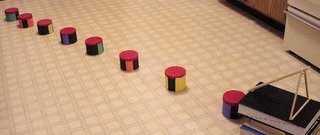Years ago I really liked the game called Bing Bang Boing, I wanted to get one for the kids but since it's no longer on the market I decided to make one for them. The game involves setting up small trampolines so that a ball bearing can bounce along a number of them in succession.
Updated Dec. 19th: Added video:

The trampolines were made by stretching balloons over empty peanut cans. A package of twenty 12" helium quality balloons was purchased for a couple dollars at a local party store, and they were cut between the neck and the widest diameter, as indicated by the line in this photo:

The balloon should be stretched taut over the can and there shouldn't be an visible slack, but don't make it overly tight or the balloon won't last very long.
You'll want to start with at least four trampolines, I bought eight cans of the least expensive peanuts and put the nuts in one of those large plastic food containers.
We used a glue stick and attached construction paper on the outside of the cans to make them look a little better.
The 12" long ramp was constructed from 1/4" square dowels, with a 3/4" brace near each end. The ramp segments are 1/4" apart, I used scrap pieces of the dowel for spacers.
Update: To make it easier to tape down the bottom of the ramp, make the brace for that end 1-1/2" long, or just glue a piece that size next to the existing one if necessary.

The support for the ramp was made from two 7-1/2" pieces, a 7" and 1-1/2" piece:

The ramp rests on the support as seen here:

Although not shown in this photo, I recommend taping the support and the bottom of the ramp to the book to keep it steady:

Instead of making a wooden ramp, another option would be to use a hard bound book with a wide groove by the spine. The book to be used as a ramp is held at an angle by other books placed under one end.
-----
By setting books under some of the trampolines the bearing can be made to go in a circular or zigzag path.

We use 1/2" ball bearings, but if you don't have any, marbles will work just as well.
Something else to try is releasing multiple balls very close together (but not touching or they will collide at the first trampoline).
After the last trampoline you could place another can to catch the bearings, or stand small action figures to be struck by them.
It's a good idea to remove the balloons from the cans when they aren't being used, or else they will weaken and tear.

-----
Back to What is it? - unusual objects
Updated Dec. 19th: Added video:
The trampolines were made by stretching balloons over empty peanut cans. A package of twenty 12" helium quality balloons was purchased for a couple dollars at a local party store, and they were cut between the neck and the widest diameter, as indicated by the line in this photo:
The balloon should be stretched taut over the can and there shouldn't be an visible slack, but don't make it overly tight or the balloon won't last very long.
You'll want to start with at least four trampolines, I bought eight cans of the least expensive peanuts and put the nuts in one of those large plastic food containers.
We used a glue stick and attached construction paper on the outside of the cans to make them look a little better.
The 12" long ramp was constructed from 1/4" square dowels, with a 3/4" brace near each end. The ramp segments are 1/4" apart, I used scrap pieces of the dowel for spacers.
Update: To make it easier to tape down the bottom of the ramp, make the brace for that end 1-1/2" long, or just glue a piece that size next to the existing one if necessary.
The support for the ramp was made from two 7-1/2" pieces, a 7" and 1-1/2" piece:
The ramp rests on the support as seen here:
Although not shown in this photo, I recommend taping the support and the bottom of the ramp to the book to keep it steady:
Instead of making a wooden ramp, another option would be to use a hard bound book with a wide groove by the spine. The book to be used as a ramp is held at an angle by other books placed under one end.
-----
By setting books under some of the trampolines the bearing can be made to go in a circular or zigzag path.
We use 1/2" ball bearings, but if you don't have any, marbles will work just as well.
Something else to try is releasing multiple balls very close together (but not touching or they will collide at the first trampoline).
After the last trampoline you could place another can to catch the bearings, or stand small action figures to be struck by them.
It's a good idea to remove the balloons from the cans when they aren't being used, or else they will weaken and tear.

-----
Back to What is it? - unusual objects